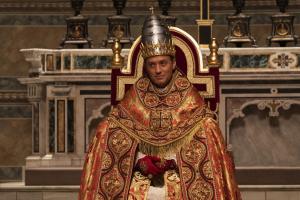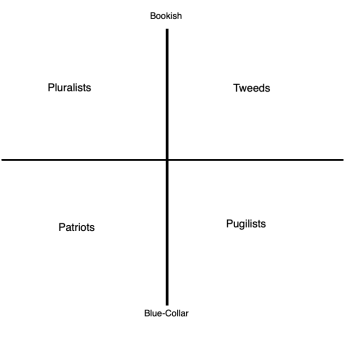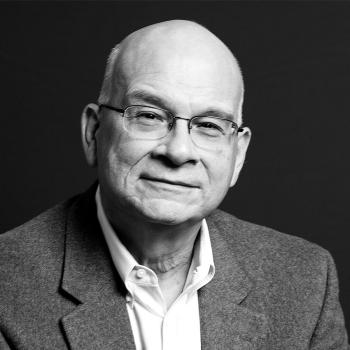
As plenty of culture observers have remarked, mainstream cinema seems to be stuck in a narrative rut. There have been more than four dozen Marvel films released since 2000, Star Wars movies have positively proliferated since Lucasfilm’s sale, Disney continues to pump out uncanny live-action versions of its animated classics, and it seems like every moderately successful 1980s action flick has gotten a big-budget sequel or spinoff in the last decade. There are plenty of small-scale exceptions to this trend—just in the last few months, we’ve gotten Céline Sciamma’s Portrait of a Lady on Fire, Benh Zeitlin’s Wendy, Galder Gaztelu-Urrutia’s The Platform, and plenty of others—but, by and large, genuinely wild creativity seems to be in shorter and shorter supply.
Paolo Sorrentino’s two Catholic-themed HBO series—The Young Pope and The New Pope—defy that trend. They’re strange, sprawling, chaotic, and beautiful experiences that, even if they’re never quite as profound as they believe themselves to be, nevertheless provoke in the best of ways.
2016’s The Young Pope begins with the elevation to the papacy of fortysomething American cardinal Lenny Belardo (Jude Law), whom a cabal of Vatican cardinals believes they can control. But it immediately becomes clear that Lenny, Pope Pius XIII, is no puppet—and certainly no supporter of the liberalizing “spirit of Vatican II.” Lenny’s theology is demanding and ultraconservative, with shades of Joseph de Maistre: in one of the series’ best scenes, he demands—with complete seriousness—the return of the papal states from the Prime Minister of Italy. That said, he is not without a flair for the theatrical: like Benedict XVI, Lenny eschews the simple white cassock in favor of the elaborate papal vestments he is technically entitled to wear, leading to a delightful montage in which Lenny, suiting up for a gathering of the Roman Curia, dons the papal regalia to the tune of LMFAO’s “Sexy and I Know It.” And of course, along the way viewers meet a cast of colorful characters including the conniving Vatican Secretary of State, Cardinal Voiello (Silvio Orlando), Lenny’s surrogate mother, Sister Mary (Diane Keaton), and the Mary Magdalene-esque Esther (Ludivine Sagnier).
2020’s The New Pope begins where its predecessor left off: Lenny is in a coma after the revelation that, as a teenager, he performed a genuine miracle and is a candidate for sainthood. Following an abortive attempt by Voiello to install a more compliant pope—Francis II, who promises to sell off the Church’s assets to feed the poor—the erudite Sir John Brannox (John Malkovich) is elected as Pope John Paul III. Brannox is a former Anglican famous for his book “The Middle Way” urging moderation in the reform of the Church. But Brannox isn’t the main attraction on offer. Instead, much of The New Pope is occupied with the potential effect of Lenny’s miraculous awakening from his coma: following his hospitalization, a cult of devotees has sprung up around him, seeing him as not only a living saint, but possibly the return of Christ Himself.
Because The Young Pope and The New Pope are HBO shows, the usual caveats apply: there are plenty of subplots that go nowhere, lots of flamboyant scene-chewing, and some unnecessary nudity. But beyond that, both series center on a genuinely fascinating concept: how the Vatican community—and the world at large—responds to a genuinely premodern Pope. (It’s also probably the closest that modern Western cinema will ever get to portraying integralism in a quasi-positive light—or at the very least, not as a caricature.) The haunting effect of this is compounded by the fact that Lenny’s miracles are real. The genuine presence of the supernatural pervades every episode, even though it’s also made clear that God’s power cannot be invoked in a mechanistic fashion. At its best, the series dares to ask a deeply unsettling question: what if Lenny’s right? How would a true prophet, clearly anointed by God, upset all our expectations about what the world should look like?
(Spoilers to follow)
Alas, The New Pope’s finale lacks the courage to follow through on its predecessor series’ sobering vision, and instead opts for a contrived moral dilemma. In the midst of a hostage situation that—as news reports at the time indicate—was provoked by a Muslim caliph, a revived Lenny threatens to reveal himself to the world, ushering in an age of Catholic fanaticism and paving the way for a global clash between Catholicism and Islam. It’s an abrupt character shift for Lenny—from vessel of God to architect of destruction—and it’s ultimately Brannox, the voice of moderation, who ultimately talks him off the ledge and convinces Lenny to preach a more compassionate faith.
But in so doing, the series undercuts the very thing that made it so compelling: encounter with the sheer otherness—for better or worse—of a society structured by tradition rather than by liberal values. And that, from a storytelling perspective, is a real disappointment. I get it—given HBO’s target audience, an overarching “anti-extremism” message isn’t surprising. Yet for a show that paid real attention to what religious convictions truly entail for those who take them seriously, Lenny’s choice to trade rigor for Brannox’s centrism comes off as showrunner nervousness rather than true character progression. (To be clear, Lenny’s decision to start a modern-day crusade would’ve also been a storytelling failure; the point is that the entire setup of the finale is untrue to the ethos of the preceding episodes.)
From a Lutheran standpoint, there’s certainly a fair amount here that reflects the problems of the papacy that sparked the Reformation (in particular, the decidedly not-Holy Spirit-inspired machinations of the Curia). And it’s plain that at least some of Sorrentino’s fascination with the Vatican is aesthetic rather than theological: the formal trappings of the papacy are inordinately emphasized, and nobody’s issuing encyclicals or talking about synodal processes.
But speaking at least for myself, Sorrentino’s two series strike me as a kind of (perhaps unintentional) wake-up call to a complacent church What would it mean to say this far and no farther to contemporizing trends—to fully and defiantly embrace a countercultural identity, come what may? I certainly don’t know what that would look like across the board, but it’s something worth pondering nevertheless.












